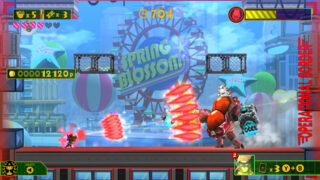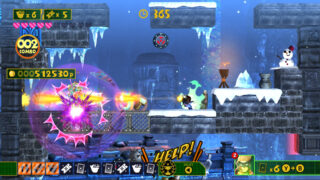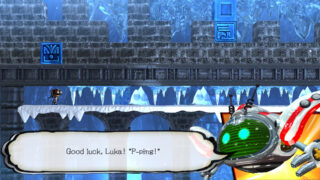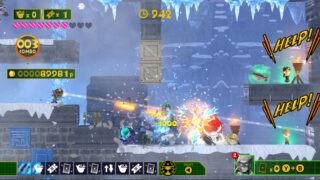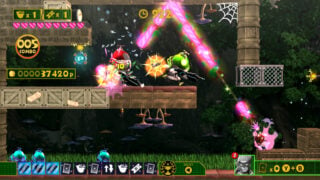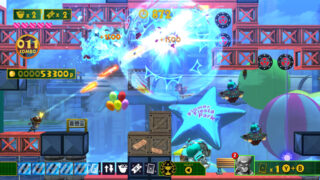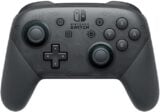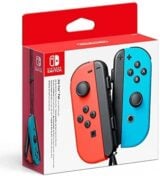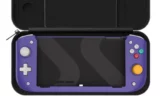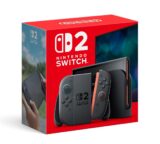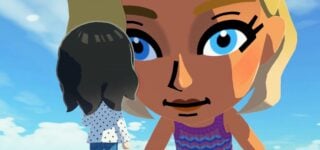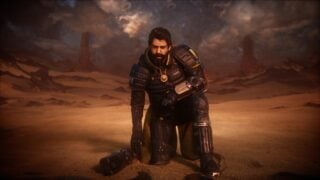Interview: Platinum explains why The Wonderful One needed to go solo
Vice president Hideki Kamiya, director Yosuke Matsumura and producer Yuji Nakao discuss the standalone release

The last time we spoke to PlatinumGames was in October, a few months after it had hired former Nintendo exec Takao Yamane as its vice president and CBO.
It’s been a busy nine months since then, with the release of not only the long-awaited Bayonetta 3 but also a surprise spin-off in the shape of Bayonetta Origins, both of which were met with widespread critical acclaim.
Most recently, in June it released The Wonderful One: After School Hero, a 2D action platformer which had originally been added as free DLC for The Wonderful 101 Remastered, and is now available as a standalone paid product.
Naturally, when we visited the company’s Osaka headquarters again the The Wonderful One was one of the main discussion topics, but during our two-hour chat we also managed to fit in a range of other topics, such as the ongoing ‘JRPG’ debate, localisation woes and hidden old-school arcade gems.
We sat down with PlatinumGames vice president Hideki Kamiya, The Wonderful One’s director Yosuke Matsumura and its producer Yuji Nakao.

Now that it’s been a few years since The Wonderful 101 Remastered, are you happy with how it was received?
HIDEKI KAMIYA: We originally released The Wonderful 101 on Wii U, and I think the overall development schedule that we had when we released the game was a little bit tight on time, so there were quite a lot of areas which we felt were somewhat incomplete when we released the game initially, and we felt that we really needed to brush up quite a lot of those areas.
We felt that the remastered version of The Wonderful 101 allowed us to release the game on an even bigger platform, starting with the Nintendo Switch.
As to the key word in the title, Remastered, it wasn’t really something that was pertinent to the graphics, it was more in terms of content, where we felt it was lacking in the original game. It also made the gameplay more fun and more accessible to a wider userbase. So it was a great chance for us to actually have this new hardware on which we could release this remastered edition.
YUJI NAKAO: I remember The Wonderful One: After School Hero came about as a conversation between myself, Kamiya-san, and Sato-san (the director of The Wonderful 101 Remastered). We were chatting about the game and talking about some ideas as to how we could continue the franchise.
The game itself was a stretch goal for our Kickstarter campaign, so we decided to go with this side-scrolling action for The Wonderful One.
KAMIYA: After we spoke about what sort of game The Wonderful One would be like, we were discussing who we could have as the director of the game.
Consequently, Matsumura san had just finished on his part for the Babylon’s Fall project and was available to work on The Wonderful One. In one of his one-on-ones with his manager he mentioned that he was interested in pursuing the role of game director going forward.
Based on that discussion, we passed the ball to Matsumura-san, and basically told him, ‘think about what sort of game you want to make, and go ahead and take the role of director for The Wonderful One’.
Was The Wonderful One inspired by any classic 2D action games in particular? It seems like the sort of game Treasure would have made in the N64 era, like Bangai-o or Mischief Makers.
YOSUKE MATSUMURA: The main influence was the NES version of Super Mario Bros. When I would think about our game’s level construction I would move over to Super Mario Bros and get inspiration, get ideas from that so I could continue working on my own levels.
Kamiya-san would walk by my desk and see Super Mario Bros on the screen and ask ‘why are you playing that?’ and I would explain it was just for inspiration for The Wonderful One.
“Kamiya-san would walk by my desk and see Super Mario Bros on the screen and ask ‘why are you playing that?’ and I would explain it was just for inspiration for The Wonderful One.”
KAMIYA: I wasn’t directly involved in game design for The Wonderful One, instead handling the overall supervision.
In the past, though, I created another 2D side-scroller called Viewtiful Joe, and in that game there were items called V-Films. The way I would line those items up in the level was similar to the concept of having coins in Super Mario games.
So the coins in those levels are placed intentionally to make the player follow a certain path to collect them, and that was the inspiration I took for the V-Film items in Viewtiful Joe.
So thinking about that concept, both Matsumura-san and myself worked that idea into our games where we’d place items on the stage itself to create a certain path for the player to follow as they play through the game.
So Super Mario was definitely a big inspiration for both of our titles and the advice I gave to Matsumura-san was to explore and follow this concept for The Wonderful One.
When you’re studying Super Mario Bros, what kind of things are you looking for? The pacing, the challenge, the placement of gaps? What are you looking to learn from on a technical level?
MATSUMURA: The biggest thing was actually the pacing. Obviously, I did look at several other components on how to structure the levels, but pacing was one of the main ones.
We didn’t want to make one level really long, we wanted to make it short and sweet with a lot of replayability, and allow players to go back through the levels and beat them in a different way.
So how to beat the stage was another element that we thought about, but pacing was the biggest influencer in this case.
KAMIYA: We did reference Mario a lot when it came to level design. In the original Super Mario Bros you have your World 1-1, 1-2, 1-3 and 1-4 and then you’d face Bowser. And in The Wonderful One you have Drill 1-1, Drill 1-2 and then you face the boss, so it’s kind of similar in that respect. The influence was definitely there.
MATSUMURA: I think also in terms of controlling Luka, his speed – especially when using his dash – felt awkward to control. Mario then came up in conversation once again.
KAMIYA: There was a bit too much inertia after you moved him, which felt a bit weird and uncontrollable. So what we did was go back and look at Super Mario again and referenced that, saying ‘well, maybe we can adjust that so it looks and feels a little bit more like Mario in terms of his jumping and general movement’.
In terms of side-scrolling games in general, we were inspired by Contra. In a game like that, probably because of the classic controls of the time, it was very difficult to shoot up and down when you were moving the character.

So in The Wonderful One we looked at other classic games that were similar to Contra in nature, such as Forgotten Worlds and Ikari. In those games you had separate controls for moving the character and shooting, and that’s what we looked at replicating in The Wonderful One and delivering a stress-free shooting experience.
That means in our game you can easily aim your lasers while moving the character, so there’s no real stress when trying to perform both actions at the same time. So I think we pulled it off really well to allow the player to independently control those two functions.
The Wonderful One was released as free DLC for The Wonderful 101 Remastered, but now it’s also available as a standalone title. What was the thinking behind this?
NAKAO: Mostly it’s to get more players playing The Wonderful One and to introduce more players into the Wonderful 101 universe.
When we first created The Wonderful One the overall intent was that we wanted to create something for our Kickstarter backers, and we wanted to create a fresh new game experience that was a completely different genre to the original game.
After we completed the DLC, I showed the game to our president Inaba-san and vice president Yamane-san and I told them that it would be great to release this as a standalone package. They saw the game and really liked it, and gave us their ok to go ahead and release a standalone version of the game.
As I recall, Yamane-san was the one who said ‘go ahead and just make a standalone version, this is going to be good’. So that’s how the standalone version came to be, honestly speaking.
The aim from our end was that it’s been a long time since The Wonderful 101 was originally released, so we had a lot of fans of the franchise still waiting for a new experience from the IP itself. So we wanted to create something fresh and give a new approach to the players who want to revisit the franchise, so this 2D side-scrolling action game was a perfect fit.
“The aim from our end was that it’s been a long time since The Wonderful 101 was originally released, so we had a lot of fans of the franchise still waiting for a new experience from the IP itself.”
I think it’s a really fun experience on its own, and if players purchase it and have fun with the game that’s fine, they can stop there. But we also wanted to link that to the existing Wonderful 101 Remastered game and allow players to get more of the overall Wonderful 101 story after they’ve finished playing The Wonderful One.
KAMIYA: To add to that, we were really confident about The Wonderful One experience, hence the decision to release this as a standalone game.
One of PlatinumGames’ core beliefs is that we really try to incorporate unique ideas and concepts into our game, and one of the first of those unique ideas for the original Wonderful 101 was the Unite Morph feature.
For the Wonderful One we also wanted to express some unique ideas and concepts for the game, and that included allowing the player to shoot their lasers in all directions while running about. That’s why we were sure that the game would work well as a standalone experience.
The Wonderful One appears to have a similar gameplay style to Vol 5 of the Neo Classic Arcade series (the so-called ‘Pt Spectacular Side-Scrolling Action’ which has the tentative title ‘Cutie Pt’). Did the same team work on both, and are any of the lessons learnt while developing The Wonderful One being carried over to development of that game?
KAMIYA: When the team was talking about that, we actually thought it would be good to revisit Vol 5 of the Neo-Classic Arcade series after we’d completed work on The Wonderful One.
We’re using some of the know-how that we gained during The Wonderful One and are reusing it in Vol 5. Obviously, we’ll include unique pillars and concepts for Vol 5 on its own, but it would be good to use some of the ideas and experiences that were built in The Wonderful One and fuse those into Neo-Classic Arcade Vol 5.
So is it the same team working on Neo-Classic Arcade Vol 5?
KAMIYA: It’s completely different teams working on both games.
Bayonetta 3 got a spin-off in Bayonetta Origins, which was a completely different genre of game. The Wonderful One is also a completely different genre to The Wonderful 101. Is this a strategy Platinum is looking to implement again in the future to explore its series in different ways?
KAMIYA: Generally speaking, our teams love the games they create, and it’s not like we’re thinking of proliferating each IP in particular, but we do want to create unique experiences and have players enjoy those games.
The teams are always talking about other possibilities on the development floor, and there’s quite a lot of love behind the titles, and that love can lead to new ideas that lead to creating different experiences.
We do kind of want to do pretty much anything to provide that fun element to our players, so I think The Wonderful 101 series is something we’ll definitely be thinking about moving forward, so who knows. But ideas are always on our mind, for doing new cool stuff.
NAKAO: Usually, we do exchange these ideas on ways to make new, fun experiences for our existing games. One idea we had was DLC that let the player control one of The Wonderful 101 enemy characters, Prince Vorkken – I spoke to Kamiya-san about an idea for that and said ‘it would be good to make that sort of experience’.
It’s a daily discussion amongst the teams, and if we have a good idea we’ll run it by each other and think about future possibilities.
Does it feel good to be able to have those creative brainstorms with an IP? Not too long ago one of Platinum’s big frustrations was that it wanted to have its own IPs to be able to make decisions like that.
KAMIYA: One of the good things about PlatinumGames is that we have a deeply rooted creative culture in the company. One of the ways this manifested was through the game The Wonderful One, but we always try to uncover new creative talent within the company and allow them to create these new unique experiences for our players and fans.
With regards to Matsumura-san, for example, allowing younger creators like himself to gain creative experiences on these new titles is something we really want to try and push for at PlatinumGames, to give our young employees this chance to show their creative talent going forwards.
“With regards to Matsumura-san, for example, allowing younger creators like himself to gain creative experiences on these new titles is something we really want to try and push for at PlatinumGames, to give our young employees this chance to show their creative talent going forwards.”
But in many of our conversations in the past there was frustration, in that if, for example, the team wanted to make a spin-off of MadWorld they would have to go and ask for permission because it wasn’t their IP. Was it refreshing to have a franchise like The Wonderful 101 where you can make a spin-off, and experiment within that franchise and try new things with your younger creators?
KAMIYA: We did manage to create this unique 2D side-scrolling experience through the exchange of ideas within the team. However, it’s difficult for me to answer this as a creator who works directly with the development team but the whole experience was fun and refreshing. This was our dream, perhaps, since the inception of PlatinumGames as a company.
We can’t say whether it was difficult, frustrating, or suffocating, even, to have restrictions on whether we could create a spin-off or other experience for an IP that we didn’t have rights to, but as a developer we do have to collect those experiences and make something out of it – regardless of the actual IP we’re working on, whether it’s ours or not.
I don’t think it was suffocating to have certain restrictions on some of the non-Platinum Ips that we’ve worked on – obviously we had to do that as a developer – but moving forward I think this whole experience we had with The Wonderful One was refreshing in the sense that it did allow us to explore this with more freedom in terms of what we wanted to do with the IP.
Is there any clarification on whether the Wonderful 101 IP is with Platinum now, or did you have to ask Nintendo for permission to make the spin-off?
We cannot disclose details of the contract since another company is involved, but PlatinumGames holds the copyright for The Wonderful 101: Remastered and The Wonderful One: After School Hero. That’s all we can say.
There’s been some debate online about the term ‘JRPG’ recently, after Final Fantasy 16 producer Naoki Yoshida suggested the term used to have negative connotations and that he just prefers using the term ‘RPG’ for everything. As notable creators in Japan, do you have any feelings either way about the term ‘JRPG’?
NAKAO: I think my sentiment is the complete opposite of what Yoshida-san said. You have your RPG genre and JRPGs, as a sub-genre, are kind of unique in their own right.
They have a certain kind of character, so I think it’s a fairly okay term to use to describe that sub genre, it’s not something that I feel has any negative connotation or could be taken in a negative manner.
KAMIYA: I have a lot to say on this. Just to be clear first though, I have a positive sentiment when it comes to the term JRPG. Indeed, I think it’s something that we should be proud of.
“I have a positive sentiment when it comes to the term JRPG. Indeed, I think it’s something that we should be proud of.”
In my creative life up until now there have been two things that left a huge impression on me, which I still think about to this day. The first of these was a localisation issue with the manga of Fist of the North Star.
In the first issue of the manga, on the first page, it had the bad guys, the thugs, on their motorbikes on top of a hill. They were looking down at the village, getting ready to go and attack the villagers. In the background you have this sort of onomatopoeia unique to manga, a sort of ‘dododododo’ sound, which is used to express the bad guys coming. To show that the bad guys are there, and to portray the fact that they’re really strong and powerful and ready to go on the attack.
What the creators wanted to do in this first scene was to express the atmosphere that something bad was coming and the sheer force exerted by the presence of the bad guys. It doesn’t actually go ‘dododododo’, but we can ‘feel’ the sound and the tension it represents.
These sounds that are expressed in Japanese, that’s something that’s been proliferated over the years, you see it a lot in JoJo’s Bizarre Adventure as well. And this ‘dodododo’ sound was used to show that the bad guys are really powerful and strong, and that the protagonist would have to face something very difficult to overcome.
However, in the localised version of Fist of the North Star, they changed that sound to something like ‘vrooooooom’, to express the sound of the thugs’ motorbikes. So the sound was no longer used to hint at the presence of the bad guys and how strong they were, it was just representing some actual engine noises, which is different to what the manga’s illustrator Tetsuo Hara and the team intended when drawing the manga.

Using language to express a unique atmosphere such as this is something that’s fairly unique to Japanese creative tastes, in a sense. It’s something that you can’t really express in other cultures so well, when you see it from a localisation perspective.
The second thing was Ultraman, which was usually made in Japan but there was one series that was made in America. When you have Ultraman taking off, in the Japanese version you just have the sound of him taking off. There are no special visual effects or anything behind him but you have the sound of a jet taking off, like ‘WHOOOOOOSSSSHHHHHHH!’
But there was a version of Ultraman called Ultraman Powered, which was made in the States, and Skywalker Sound actually did the sound effects for it. And the difference between the two, when it comes to Ultraman himself taking off, was that in the American version you only heard a tiny whoosh effect when he took off.
It wasn’t as pronounced as in the Japanese version because there were no visual effects to accentuate the jet propulsion, hence the conservative SFX choice from the American creators. And you can see these minute differences between Japanese and non-Japanese creators, in a sense.
When you have Ultraman, who’s 50 metres tall, taking off, you have Japanese creators who are more focused on making more unique, creative sounds to portray him taking off and flying, versus American creators who are focused more on the realistic side of Ultraman – they felt that because he didn’t have any visual effects behind him it would be better to have more subdued sound effects to match.
So it left quite the impression on me when I saw the American version of Ultraman because of how much they focused on reality when trying to match Ultraman’s sound effects to his visual effects. The American portrayal of Ultraman was also cool, because it made it feel like a 50m tall giant was about to launch up in the air.
It’s not really a case of good versus bad – whether Japanese or American creators created the more positive portrayal of Ultraman – it’s more the unique differences in our culture and how our influences affect our creativity, the fact that Japanese creators have this unique sense when we do create content.
So now we come to the main point I’m making… When we started PlatinumGames, the first thing we decided was to create Bayonetta, that was something that had already been determined. We wanted to create an experience that would be accepted by a global audience.
So the next thing we started wondering was what sort of game we should create to appeal to a global market. I had previous experience with Devil May Cry, and at that time other action games from non-Japanese developers were becoming worldwide hits and making their way into Japan, the first notable one being God of War.
When you look at God of War, you have Kratos. He’s muscly, he’s huge, he’s bald, he looks really kick-ass, basically. So we thought ‘okay, we have games like this which are becoming more popular globally, could we create something similar from a Japanese standpoint?’
We discussed this internally and the conclusion was that no, we obviously can’t, because this is something that’s not unique to us as Japanese creators. So in order to make an action game that would stand out we needed to create something that expressed our unique sensitivities as Japanese creators, and Bayonetta was a result of that.
When you look at Bayonetta as a character, she doesn’t look strong like Kratos, she doesn’t look like she could take on these massive demons, but she was very unique in the way she was created, in the way we view action game heroes, from a unique Japanese viewpoint.
“When you look at Bayonetta as a character, she doesn’t look strong like Kratos, she doesn’t look like she could take on these massive demons, but she was very unique in the way she was created, in the way we view action game heroes, from a unique Japanese viewpoint.”
Looking at God of War and other western action games, those are great experiences and very original, made by creators in their respective regions, and it’s something we could not replicate even if we tried.
If Bayonetta was labelled as a ‘J-Action’ game, I would not have anything against that nomenclature. We are very proud of Bayonetta and the character we came up with because she is the essence of our kind of unique creativity as Japanese creators.
So when it comes to the term ‘JRPG’, this is something that ties into this – these are RPG games that, in a sense, only Japanese creators can make with their unique sensitivity when it comes to creating these experiences. I think it’s certainly something that should be celebrated moving forward, and someone should actually aim to make a ‘king of JRPGs’ game to express that. As Japanese game creators, we’re very proud of the actual term JRPG.
So I suppose in that sense you wouldn’t be offended if games like Bayonetta were categorised as ‘J-action’ games?
KAMIYA: On the contrary, I’d be very proud if you used that term! As I said, I would be nothing but proud if you used the term ‘J-Action’ for Bayonetta. It’s more focused than the broad genre of action and it highlights the unique elements that only Japanese developers can make. So yeah, if you wanted to do that, go for it, we’d be proud more than anything else.
“I would be nothing but proud if you used the term ‘J-Action’ for Bayonetta. It’s more focused than the broad genre of action and it highlights the unique elements that only Japanese developers can make.”
[Kamiya holds his hands out wide]
Action.
[he narrows his hands]
J-Action.
[he brings his hands together]
Kamiya Action. [laughs]
Speaking of localisation, have there been any examples of localisation altering any elements of your past titles in ways that you didn’t intend?
KAMIYA: Well, for The Wonderful One we had two members of staff who worked on the localisation. I was fairly busy so I didn’t have time to look at the localised text, but there were one or two areas I wanted to discuss further to make sure the intent of the game creators was actually better expressed through localisation.
As an example, there’s a conversation fairly close to the start of the game and Luka and Sue are talking. In Japanese they’re saying something like “I’m going to tell Mr Wedgewood that you ate his lunch”, but in the English version it was changed that to something like “I’m going to tell Mr Wedgewood that you threw a paper plane at him”.
So some changes were made from a cultural perspective – in this case, to represent the differences in school culture in Japan and the United States.
I understand the intent behind that – it’s better to pinpoint those cultural differences and express it through localised text, that’s fine – but at the same time, there are more alternatives we could discuss to reach a better balance between what the creators themselves wanted to express through text versus how we should localise that text, and as a creator, I felt slightly opposed to this change.
One other example from the original The Wonderful 101, there’s an item called Wonderful Ramen. At the time we were trying to find a food that was popular with kids, not just in Japan but also around the world. One of the ideas we had was Japanese-style curry, which we just call ‘curry-rice’.

In Japan, our curry is quite distinctive, and is sold in the UK now, but at the time it wasn’t something that would be instantly recognised by the players outside Japan. So we wanted something that could resonate better with the players and curry wasn’t the best option, so that’s why we came up with ramen, which was better known at the time.
There have been some other Japanese creators who want to use the word ‘curry’ in their games and they’ve run into the same issues – when you say ‘curry’ that’s not going to be a Japanese thing in particular. But it’s fun to think about these cultural differences and localise the game in a way that can be understood by players worldwide.
When you guys think about Japanese curry – in the UK you do say katsu curry, don’t you?
We do, yes, but in the UK when we think about curry we usually think about Indian curry. Chicken tikka masala is one of our national dishes, so to us curry is usually seen as an Indian dish.
KAMIYA: Oh. But in the UK, when you guys say katsu curry… for us, katsu is the cutlet.
Finally, we know you’re a big fan of retro games, Kamiya-san, particularly the Arcade Archives series released by Hamster Corporation. Every week you’re tweeting about the latest release, so it’s clear you have a passion for it. Including its separate Neo Geo series, Hamster has now re-released more than 370 classic arcade games on modern systems – is there any retro game it hasn’t added yet that you would love to see?
KAMIYA: First of all, I don’t like the word ‘retro game’. I’m obviously not a native English speaker so it might be something I’m interpreting from a Japanese perspective, but hearing the word ‘retro’ from a Japanese viewpoint, suggests more of a “fad” brought back from a past era and reskinned for the current era.
“I don’t like the word ‘retro game’. I’m obviously not a native English speaker so it might be something I’m interpreting from a Japanese perspective, but hearing the word ‘retro’ from a Japanese viewpoint, suggests more of a “fad” brought back from a past era and reskinned for the current era.”
So I prefer the terms ‘old games’ or ‘classic games’, because they show more respect to those games of the past.
I love games from all generations, and just because the game is ‘retro’ doesn’t mean it’s retro, because it’s the same game that existed years or decades ago – it still exists and it’s still playable and it’s still an experience that’s very unique in its own right – so there’s really no need to refer to it as ‘retro’ because it still does have special memories and experiences that stay with you after all these years.
That’s why I like to use the term “classic games”.
To answer your question, do you know Gardia? It’s a shoot ‘em up like Xevious.
Oh, so you can shoot at enemies in the air and drop bombs on the ground.
KAMIYA: Yes, you can use shots for air attacks and bombs for ground attacks. But the difference is that in Xevious you had to throw bombs ahead of you.
In Gardia, the bombs are already on the level, so you have to actually press the button to detonate them. So there’s no time lag between you launching the bomb and it detonating, it does it as soon as you press the button. So there’s a huge difference.
It’s difficult to explain, but in Xevious you couldn’t throw bombs at enemies once they got close to you, because they passed over them before they detonated. But in Gardia, that’s not the case.
I definitely want you to play this game, it’s highly recommended. The only real unfortunate thing is that it only has four levels before it loops.
Was this an inspiration for Sol Cresta then?
KAMIYA: We didn’t make Sol Cresta to imitate the games of the past and bring back nostalgia, it was more than that. We wanted to make a vertical scrolling shoot ‘em up combined with our desire to introduce unique concepts in each of our games.
One example of this was the formations that we had, where the player could freely make their own formations and make attacks with them, it was something you don’t see in many other games of that kind. We brought that meaning into Sol Cresta in a sense by creating our own unique concepts and ideas and bringing those to life.
I definitely want the new generation to play Gardia, though. It’s one of the games I strongly recommend, and I want the creators who are currently active to play this game and get a lot of inspiration from it. I’ve been asking (Hamster president) Hamada-san to include this game in their Arcade Archives series!
